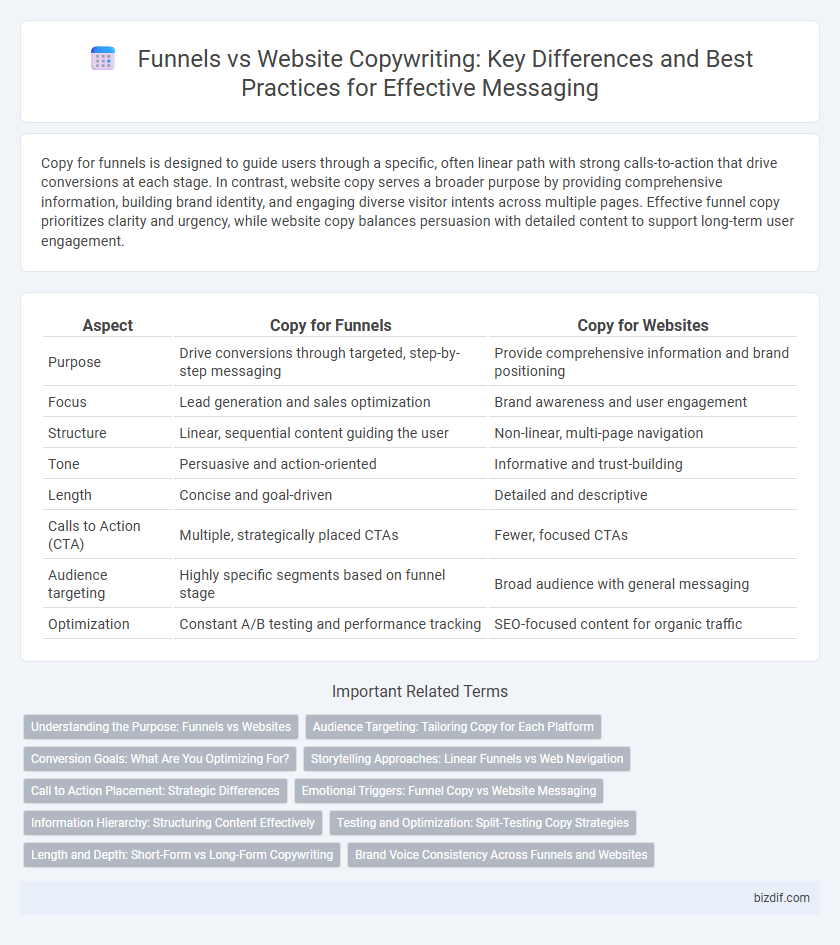Copy for funnels is designed to guide users through a specific, often linear path with strong calls-to-action that drive conversions at each stage. In contrast, website copy serves a broader purpose by providing comprehensive information, building brand identity, and engaging diverse visitor intents across multiple pages. Effective funnel copy prioritizes clarity and urgency, while website copy balances persuasion with detailed content to support long-term user engagement.
Table of Comparison
| Aspect | Copy for Funnels | Copy for Websites |
|---|---|---|
| Purpose | Drive conversions through targeted, step-by-step messaging | Provide comprehensive information and brand positioning |
| Focus | Lead generation and sales optimization | Brand awareness and user engagement |
| Structure | Linear, sequential content guiding the user | Non-linear, multi-page navigation |
| Tone | Persuasive and action-oriented | Informative and trust-building |
| Length | Concise and goal-driven | Detailed and descriptive |
| Calls to Action (CTA) | Multiple, strategically placed CTAs | Fewer, focused CTAs |
| Audience targeting | Highly specific segments based on funnel stage | Broad audience with general messaging |
| Optimization | Constant A/B testing and performance tracking | SEO-focused content for organic traffic |
Understanding the Purpose: Funnels vs Websites
Copy for funnels targets specific actions at each stage, guiding users seamlessly toward conversion, while website copy provides comprehensive information to build brand trust and answer broad visitor questions. Funnel copy emphasizes urgency and benefits to drive immediate decisions, whereas website content prioritizes clarity and detailed explanations for sustained engagement. Understanding these distinct purposes ensures tailored messaging that maximizes user experience and conversion rates.
Audience Targeting: Tailoring Copy for Each Platform
Copy for funnels prioritizes precise audience targeting by addressing specific pain points and guiding users through a step-by-step conversion process, ensuring messaging aligns with each funnel stage. Website copy requires broader targeting, delivering comprehensive brand information and engaging diverse visitor intents with a balance of clarity and persuasion. Tailoring copy to platform-specific audience behaviors enhances engagement and maximizes conversion effectiveness.
Conversion Goals: What Are You Optimizing For?
Copy for funnels focuses on driving specific conversion actions, such as lead captures or sales, by guiding users through a linear, goal-oriented path with persuasive calls-to-action. Website copy optimizes for broader engagement, brand awareness, and multiple user intents, requiring a balance between informative content and conversion elements. Understanding your primary conversion goals helps tailor copy that either streamlines funnel stages or supports diverse website navigation and interaction.
Storytelling Approaches: Linear Funnels vs Web Navigation
Copy for funnels emphasizes a linear storytelling approach that guides prospects step-by-step through a predefined path, maximizing conversion potential by maintaining focused, sequential messaging. Website copy employs a more dynamic narrative structure, allowing users to navigate non-linearly and explore various content sections, necessitating clear, concise, and contextually independent story elements. Funnel copy leverages urgency and progressive engagement, while web copy prioritizes intuitive navigation cues and modular storytelling to accommodate diverse user journeys.
Call to Action Placement: Strategic Differences
Copy for funnels strategically places calls to action (CTAs) at multiple, conversion-focused touchpoints to guide users through a curated journey, maximizing lead capture and sales. Website copy typically positions CTAs more subtly, often in navigation menus or end-of-page sections, to support broader user exploration and brand engagement. Effective funnel copy integrates urgency and relevance in CTA placement to drive immediate user responses, while website CTA placement prioritizes informative and trust-building interactions.
Emotional Triggers: Funnel Copy vs Website Messaging
Funnel copy leverages targeted emotional triggers like urgency, scarcity, and curiosity to drive immediate action, creating a sense of personal connection and momentum. Website messaging focuses on building trust and brand credibility through consistent emotional appeals such as security, belonging, and value over a longer engagement period. Understanding these distinctions enhances conversion rates by aligning copy with user intent at different stages of the customer journey.
Information Hierarchy: Structuring Content Effectively
Copy for funnels prioritizes a clear, linear information hierarchy designed to guide users step-by-step toward a specific conversion action, using focused headlines, concise benefits, and compelling calls-to-action. Website copy requires a more flexible hierarchy accommodating diverse user journeys, incorporating navigational cues, detailed content sections, and multiple entry points to engage visitors. Effective structuring in funnels streamlines decision-making, while websites balance breadth and depth to support exploration and brand trust.
Testing and Optimization: Split-Testing Copy Strategies
Split-testing copy strategies is essential for optimizing both funnel and website copy, enabling marketers to identify the most effective headlines, calls-to-action, and messaging variations. Funnel copy typically demands frequent testing of segmented user journeys and conversion points, while website copy often requires broader testing across landing pages and navigation elements. Data-driven optimization through A/B testing improves engagement rates and boosts overall conversion performance by tailoring copy to user behavior and preferences.
Length and Depth: Short-Form vs Long-Form Copywriting
Copy for funnels prioritizes short-form text designed to drive immediate action, using concise, persuasive language that highlights benefits and key features. Website copy often requires long-form content to provide in-depth information, build trust, and engage users with detailed storytelling and comprehensive explanations. Funnel copy emphasizes brevity to maintain focus and maximize conversions, while website copy supports SEO and user education through extended, value-rich content.
Brand Voice Consistency Across Funnels and Websites
Maintaining brand voice consistency across funnels and websites strengthens customer trust and recognition, ensuring a cohesive user experience regardless of touchpoint. Funnel copy demands precise, action-oriented language tailored to each stage of the buyer journey, while website copy supports broader brand storytelling and information delivery. Aligning tone, style, and messaging across both platforms amplifies brand identity and drives higher conversion rates.
Copy for Funnels vs Copy for Websites Infographic

 bizdif.com
bizdif.com